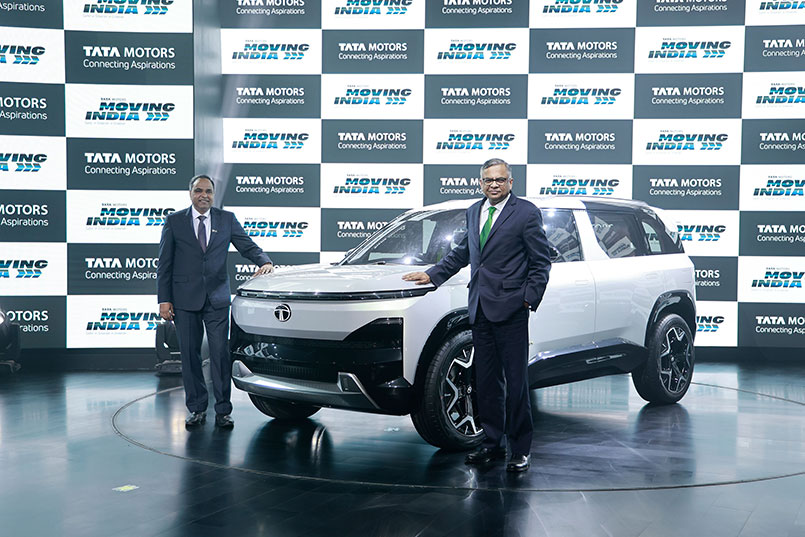Tata Motors is preparing for one of the most ambitious product strategies in its history. The Indian automaker has announced plans to expand its lineup with 7 brand-new nameplates alongside 23 facelifts and updates by the end of 2030. With a focus on both internal combustion engine (ICE) and electric vehicle (EV) segments, Tata aims to push its market presence even further, capitalizing on the success of models like the Nexon, Harrier, and Punch.
Tata’s 2030 Roadmap
By 2030, Tata Motors intends to have over 15 distinct nameplates, including ICE and EV models, catering to multiple customer segments. The company has allocated nearly ₹35,000 crore to support this expansion, with a significant part of the budget earmarked for electrification and platform development.
Tata’s aggressive strategy includes 7 new nameplates, some of which have already been teased or confirmed, like the Sierra and Avinya. Others are still under wraps, referred to by internal codenames such as ICE Product A, ICE Product B, and EV Product X and Y.
Sierra Makes a Comeback
The iconic Tata Sierra is set to return before the close of the current financial year, marking the revival of one of Tata’s most loved SUVs. The new Sierra will feature both petrol and electric powertrains, with the EV variant expected to debut first.
The Sierra EV will adopt Tata’s latest design language, first seen on the Avinya concept, featuring clean lines, futuristic styling, and next-generation tech. With the growing demand for electric SUVs, the Sierra EV could become a strong contender in the premium compact SUV segment.
Avinya Production Version
Another highlight of Tata’s future lineup is the production version of the Avinya concept. Revealed as a futuristic EV with cutting-edge technology, the Avinya will form part of Tata’s all-new electric vehicle portfolio. It will be based on the EMA platform, jointly developed with Jaguar Land Rover (JLR), offering support for advanced driver-assist systems, software-over-the-air updates, and ultra-fast charging.
The Avinya EV is expected to arrive by 2027, with the Sportback and luxury SUV versions being planned to target premium customers.
Upcoming ICE Models
While the focus is clearly shifting toward electric vehicles, Tata is not abandoning its ICE lineup. In fact, the automaker is working on two new ICE products, currently referred to as ICE Product A and ICE Product B. These vehicles will likely slot into the compact and mid-size SUV categories, where Tata has already seen success with the Nexon and Harrier.
The Harrier and Safari will soon receive petrol engine options for the first time, powered by a 1.5-litre turbocharged petrol unit. This engine is expected to feature in the Sierra as well.
Updates Across the Portfolio
Tata is planning mid-cycle updates for its existing models, including the Tiago, Tigor, and Punch. The ICE version of the Punch, in particular, is due for a major update soon, as it is one of the few models in Tata’s lineup yet to receive a facelift.
The popular Nexon, which has already undergone one major refresh, will also get a next-generation version in the coming years. This model will likely feature updated styling, improved interiors, and advanced safety features to keep it competitive in the fast-growing compact SUV segment.
Punch EV and Scarlet Compact SUV
In addition to the Punch EV facelift, Tata is preparing to introduce the Scarlet, a brand-new compact SUV aimed at younger urban buyers. This new model is expected to sit below the Nexon but offer more premium features than the standard Punch.
The Punch EV, which has already gained attention for its practicality and affordability, will see enhancements in range, performance, and connected car technology.
Nostalgic Nameplates Could Return
Tata may also revive classic nameplates like Nano, Sumo, and Estate in new avatars. While these names evoke nostalgia among Indian customers, their modern versions will likely be very different in design and technology, possibly taking the EV route to cater to current trends.
Investment and Future Goals
With ₹35,000 crore set aside for product development and manufacturing upgrades, Tata Motors is focused on achieving a leadership position in both ICE and EV categories. The brand is also expected to strengthen its presence in international markets with its new-generation products.
Tata’s partnership with JLR for platform and tech sharing is likely to play a crucial role in creating advanced EVs like the Avinya series. The upcoming models will feature ADAS (Advanced Driver Assistance Systems), connected car features, and ultra-fast charging, placing them on par with global competitors.
Why This Expansion Matters
- EV Leadership: Tata is already leading India’s EV market with models like Nexon EV and Tiago EV. The Avinya and Sierra EV will further strengthen its position.
- Diverse Portfolio: From compact hatchbacks to premium SUVs, Tata’s upcoming 30-model portfolio will cover nearly every major segment.
- Customer-Centric Design: With modern styling, improved interiors, and advanced technology, Tata’s new models aim to attract both young buyers and premium customers.
- Revival of Classics: By reviving popular nameplates like Sierra, Tata is tapping into nostalgia while offering futuristic products.
Final Thoughts
Tata Motors’ plan to launch 7 new nameplates and over 20 updates by 2030 is an aggressive yet promising strategy. The combination of ICE and EV models ensures that Tata will remain competitive in both traditional and emerging markets. With upcoming launches like the Sierra, Avinya, and Scarlet SUV, along with updated Harrier, Safari, and Punch models, Tata is building a product portfolio that appeals to a broad range of customers.
